英译汉教程8_倒装的翻译
- 格式:ppt
- 大小:263.00 KB
- 文档页数:17
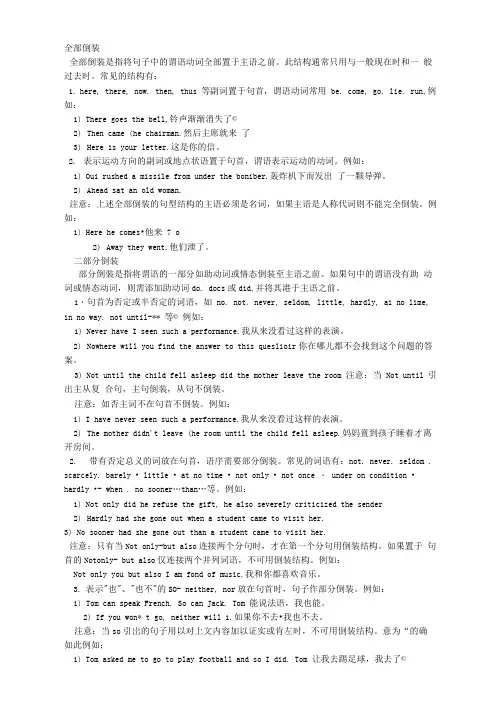
全部倒装全部倒装是指将句子中的谓语动词全部置于主语之前。
此结构通常只用与一般现在时和一般过去时。
常见的结构有:1.here, there, now. then, thus 等副词置于句首,谓语动词常用be. come, go. lie. run,例如:1)There goes the bell,铃声渐渐消失了©2)Then came (he chairman.然后主席就来了3)Here is your letter.这是你的信。
2.表示运动方向的副词或地点状语置于句首,谓语表示运动的动词。
例如:1)Oui rushed a missile from under the boniber.轰炸机下而发出了一颗导弹。
2)Ahead sat an old woman.注意:上述全部倒装的句型结构的主语必须是名词,如果主语是人称代词则不能完全倒装。
例如:1)Here he comes•他来7 o2)Away they went.他们泄了。
二部分倒装部分倒装是指将谓语的一部分如助动词或情态倒装至主语之前。
如果句中的谓语没有助动词或情态动词,则需添加助动词do. docs或did,并将其港于主语之前。
1・句首为否定或半否定的词语,如no. not. never, seldom, little, hardly, ai no lime, in no way. not until-** 等© 例如:1)Never have I seen such a performance.我从来没看过这样的表演。
2)Nowhere will you find the answer to this queslioir你在哪儿都不会找到这个问题的答案。
3)Not until the child fell asleep did the mother leave the room 注意:当Not until 引出主从复合句,主句倒装,从句不倒装。
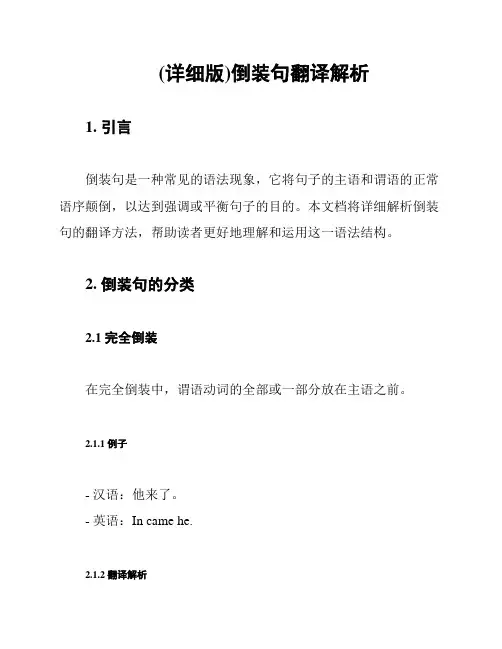
(详细版)倒装句翻译解析1. 引言倒装句是一种常见的语法现象,它将句子的主语和谓语的正常语序颠倒,以达到强调或平衡句子的目的。
本文档将详细解析倒装句的翻译方法,帮助读者更好地理解和运用这一语法结构。
2. 倒装句的分类2.1 完全倒装在完全倒装中,谓语动词的全部或一部分放在主语之前。
2.1.1 例子- 汉语:他来了。
- 英语:In came he.2.1.2 翻译解析在这个例子中,"他"是主语,"来了"是谓语。
在英语中,为了保持句子的强调,我们将主语"他"放在谓语"来了"之后,形成倒装句"In came he."。
2.2 部分倒装在部分倒装中,只有助动词或情态动词放在主语之前。
2.2.1 例子- 汉语:他能来。
2.2.2 翻译解析3. 倒装句的翻译方法3.1 确定主语和谓语首先,我们需要确定句子的主语和谓语。
主语是句子讨论的主要对象,而谓语则描述主语的动作或状态。
3.2 判断倒装类型根据句子的倒装类型(完全倒装或部分倒装),确定谓语动词的位置。
3.3 保持句子平衡在翻译倒装句时,我们需要注意保持句子的平衡。
如果句子中的其他成分过长或复杂,可以考虑使用倒装结构来平衡句子。
3.4 适当调整语序在必要时,我们可以适当调整语序,使句子更符合目标语言的语法惯。
4. 结论倒装句是一种常见的语法现象,通过将句子的主语和谓语的正常语序颠倒,可以达到强调或平衡句子的目的。
在翻译倒装句时,我们需要注意确定主语和谓语、判断倒装类型、保持句子平衡和适当调整语序等方面。
通过掌握这些翻译方法,我们可以更好地理解和运用倒装句。
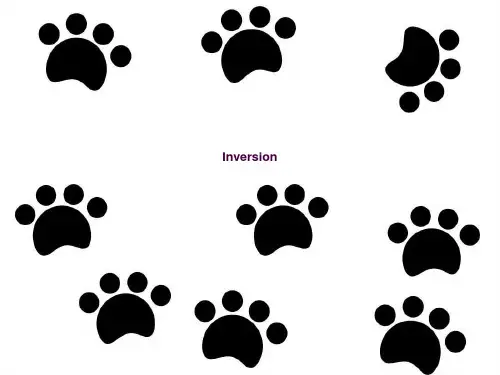
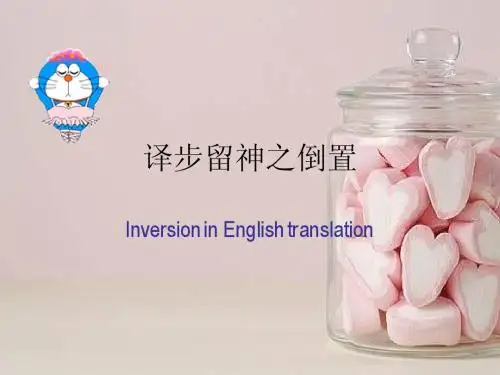
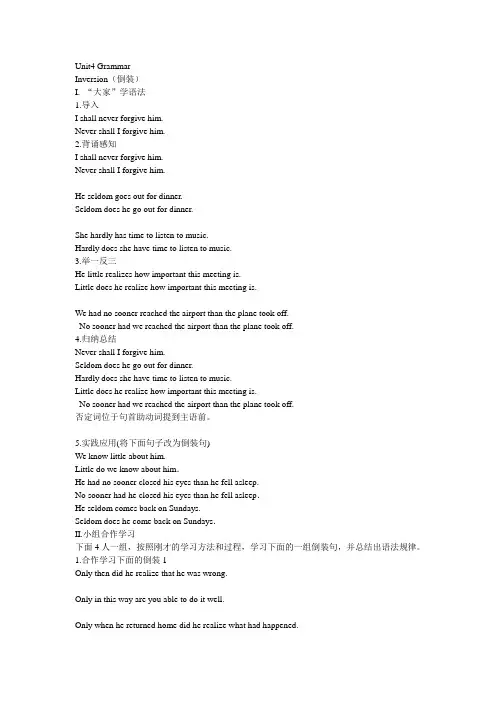
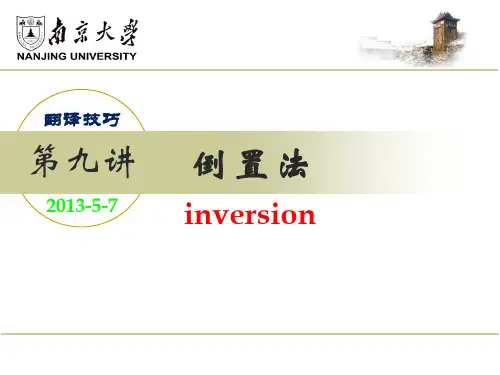
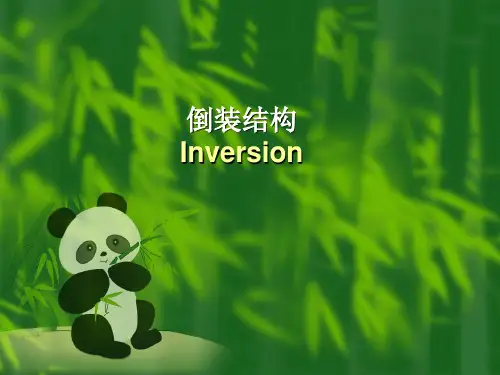

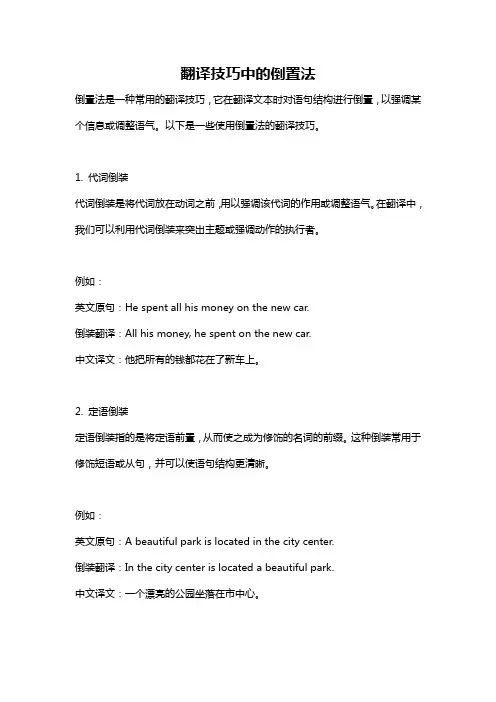
翻译技巧中的倒置法倒置法是一种常用的翻译技巧,它在翻译文本时对语句结构进行倒置,以强调某个信息或调整语气。
以下是一些使用倒置法的翻译技巧。
1. 代词倒装代词倒装是将代词放在动词之前,用以强调该代词的作用或调整语气。
在翻译中,我们可以利用代词倒装来突出主题或强调动作的执行者。
例如:英文原句:He spent all his money on the new car.倒装翻译:All his money, he spent on the new car.中文译文:他把所有的钱都花在了新车上。
2. 定语倒装定语倒装指的是将定语前置,从而使之成为修饰的名词的前缀。
这种倒装常用于修饰短语或从句,并可以使语句结构更清晰。
例如:英文原句:A beautiful park is located in the city center.倒装翻译:In the city center is located a beautiful park.中文译文:一个漂亮的公园坐落在市中心。
3. 副词倒装副词倒装是指将副词放在动词之前,以强调副词的作用或调整语气。
这种倒装常用于修饰动作的方式或程度,并可以使语句结构更为突出。
例如:英文原句:She goes to school by bus every day.倒装翻译:By bus she goes to school every day.中文译文:她每天坐公交车去上学。
4. 状语倒装状语倒装是指将状语前置,以突出状语对动作的影响或调整语气。
这种倒装常用于修饰时间、地点、方式和原因等状语,并可以使语句结构更为突出。
例如:英文原句:In the morning, I like to drink a cup of coffee.倒装翻译:In the morning, do I like to drink a cup of coffee.中文译文:早上,我喜欢喝一杯咖啡。
5. 主谓倒装主谓倒装是指将句子的主语与谓语动词位置互换,以强调主语的作用或调整语气。

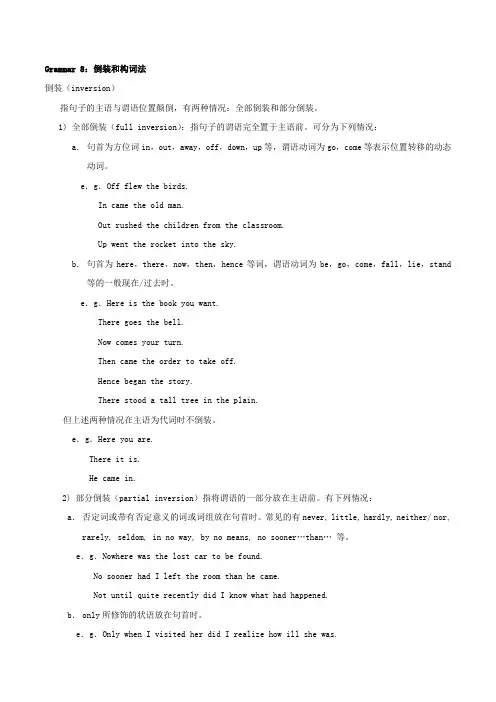
Grammar 8:倒装和构词法倒装(inversion)指句子的主语与谓语位置颠倒,有两种情况:全部倒装和部分倒装。
1) 全部倒装(full inversion):指句子的谓语完全置于主语前。
可分为下列情况:a.句首为方位词in,out,away,off,down,up等,谓语动词为go,come等表示位置转移的动态动词。
e.g.Off flew the birds.In came the old man.Out rushed the children from the classroom.Up went the rocket into the sky.b.句首为here,there,now,then,hence等词,谓语动词为be,go,come,fall,lie,stand 等的一般现在/过去时。
e.g.Here is the book you want.There goes the bell.Now comes your turn.Then came the order to take off.Hence began the story.There stood a tall tree in the plain.但上述两种情况在主语为代词时不倒装。
e.g.Here you are.There it is.He came in.2) 部分倒装(partial inversion)指将谓语的一部分放在主语前。
有下列情况:a.否定词或带有否定意义的词或词组放在句首时。
常见的有never, little, hardly, neither/ nor, rarely, s eldom, in no way, by no means, no sooner…than… 等。
e.g.Nowhere was the lost car to be found.No sooner had I left the room than he came.Not until quite recently did I know what had happened.b.only所修饰的状语放在句首时。
1.My sister did not set out until I came back.2.You will not succeed one day until you work hard.3. He had no sooner entered the classroom than the telephone rang.4.I have seldom heard such a beautiful song.5.I can not sing the song, Jim can not sing the song either.6.He is so old that he walks slowly.7. He spoke loudly so that he could be heard by all the people。
1、我刚躺下,电话铃就响了。
2、他过去从未见过这么宽的河。
3、在房间的后面是一座小山,山上有许多果树。
4、你昨天要是早一点到,你就能看见他父亲了。
5、任何地方都找不到一条船载我们过河。
6、只有在森林深处我们才可能找到这么奇妙的植物。
7、知道比赛已经开始他才来到运动场。
8、任何情况下我们都不首先使用核武器。
9、他从不喜欢这个房间。
10、他从没有预料到这项工程会完成得这么快。
1)从山谷中传来让人害怕的声音2)他们想做什么就做什么的日子一去不复返了3)他刚一离开事故就发生了。
(no sooner... than...)4)我们找到了梦寐以求的工作,一生从未这么高兴过。
(never)5)当他们野餐时,不仅带了零食和饮料,而且还带了娱乐用的扑克牌。
(not only...but also...)2.我永远忘不了我入党的那一天(never)3.只有通过练习,我们才能学好英语口语4.只有当我们冷静下来,我们才能解决这个问题5.我没有去过那儿,他也没去过6.他不仅打球打的好,他还会弹钢琴7.直到宣布完结果,我们才回家8.遇到困难我从不会放弃1.村子里住着一位老渔夫。
倒装全倒1.prep. phrase + be/link + adv. + vi + S + prep, phraseadv.(direction) + vi.(move) + S (here, there, then, now) (up, down, out, in. etc) thus vt.(passive)2. C + be +S(long)半倒1.adj, adv, none, v. +as +S +…adv,2 only prep. phrasenot until + time 倒后~ + S(clause)3not only + ~ S……. 倒前but also…….So + adj./ adv. + ~ S……that…….Such + (none) + ~Hardly/scarcely + had + S + done …….when…….No sooner………………………………than…….4. neither/never ~…….. 双倒nor/never ~…….5. –no—(by no means/ under no circumstances/ in no time/ in no way) ~nowhere / in vane ~not+…eg. I don’t study for myself.= not for myself do I study.6.never/seldom/rarely/barely often/always long/well few/little ~many a time/ now and then/ every other day/ once a week ~7.(positive)……., so ~ S(negative)……., neither/nor ~ S(two sentences or more)……, so it is/was with + S8.(If) had + S +done….., S + would have done…..were + S + C……, S + would do……should +S + dowere + S + to do/C……., S + would do…….9.there be + S + +prep, phrase eg. On the table there is a cup.= Prep. phrase+ there be + S = prep. Phrase + be + S =there + prep. phrase +be + S eg. There on the table is a cup.10.Go where you will, you will see a new look. = wherever you go,……Say what you may, I won’t change my mind.= whatever you may say,……Be the weather what it may, I’ll go out.。